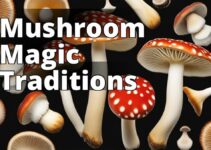Amanita mushrooms are a fascinating group of mushrooms that have captured the attention of scientists, traditional healers, and food enthusiasts alike. These mushrooms are found in a wide range of habitats across the world, and they are known for their unique properties, including their psychoactive and medicinal effects. In recent years, Amanita mushrooms have also gained popularity as a food source.
Overview of Amanita Mushrooms
Amanita mushrooms belong to the Agaricales order of fungi, which also includes mushrooms such as shiitake and portobello. There are over 500 species of Amanita mushrooms, and they are recognized by their distinctive features, including their cap shape, color, and the presence of a ring around the stem. Many species of Amanita mushrooms are toxic, and some are deadly. However, there are also edible species that have been used as food for centuries.
Habitat and Unique Properties of Amanita Mushrooms
Amanita mushrooms are found in a variety of habitats, including forests, woodlands, and grasslands. They are known for their unique properties, including their psychoactive and medicinal effects. Some species of Amanita mushrooms contain psychoactive compounds such as muscimol and ibotenic acid, which can cause hallucinations and other effects when ingested. These compounds have been used in traditional medicine for centuries, and they are still used today in some cultures.
Traditional Medicinal Use of Amanita Mushrooms
Amanita mushrooms have a long history of use in traditional medicine. In many cultures, they are believed to have healing properties and are used to treat a variety of ailments, including headaches, fever, and digestive issues. Some species of Amanita mushrooms are also believed to have immune-boosting and anti-inflammatory effects.
Growing Popularity of Amanita Mushrooms as a Food Source
In recent years, Amanita mushrooms have gained popularity as a food source. Edible species such as Amanita caesarea and Amanita muscaria var. guessowii are prized for their flavor and nutritional value. Amanita mushrooms are also a good source of protein, fiber, and vitamins. However, it is important to note that many species of Amanita mushrooms are toxic and should not be consumed.
Amanita Mushroom Food Chain Summary
- Amanita mushrooms play a crucial role in the food chain as decomposers and as a food source for small animals, predators, and larger animals.
- Amanita mushrooms are also important for nutrient cycling and soil health, but overconsumption can have consequences.
- Edible Amanita mushrooms have nutritional value, but there are potential risks associated with consuming them, and it is important to understand the Amanita mushroom food chain for sustainable harvesting and ecosystem protection.
The Amanita Mushroom Food Chain
A. Role of Amanita Mushrooms in the Food Chain
Amanita mushrooms play an important role in the food chain of many ecosystems. They are decomposers that break down organic matter, such as dead leaves and wood, and recycle nutrients back into the soil. Amanita mushrooms also provide food for a variety of animals, including insects, small mammals, and birds.
B. Decomposers and Scavengers in the Food Chain
Amanita mushrooms are decomposers that play a vital role in nutrient cycling in many ecosystems. They break down dead organic matter and recycle nutrients back into the soil, which supports the growth of plants and other organisms. Amanita mushrooms also serve as food for scavengers such as insects and small animals, which play an important role in keeping ecosystems healthy.
C. Small Animals and Their Consumption of Amanita Mushrooms
Amanita mushrooms are an important food source for many small animals, including insects, rodents, and birds. Insects such as beetles and flies feed on the fruiting bodies of Amanita mushrooms, while rodents and birds consume the entire mushroom. These animals play an important role in dispersing the spores of Amanita mushrooms, which helps to ensure their survival and spread.
D. Predators and Larger Animals in the Food Chain
Amanita mushrooms are also consumed by larger animals such as deer, elk, and bears. These animals play an important role in keeping the population of Amanita mushrooms in check, as overconsumption of these mushrooms can have negative consequences on the ecosystem. Predators such as foxes and coyotes may also consume small animals that have fed on Amanita mushrooms, which can lead to the transfer of nutrients up the food chain.
The Impact of Amanita Mushrooms on the Ecosystem
A. Nutrient Cycling by Amanita Mushrooms
Amanita mushrooms play a crucial role in nutrient cycling in many ecosystems. They break down organic matter and recycle nutrients back into the soil, which supports the growth of plants and other organisms. This process helps to maintain the health and productivity of ecosystems, and it is essential for the survival of many species.
B. Soil Health and Amanita Mushrooms
Amanita mushrooms also play an important role in maintaining soil health. Their mycelium networks help to bind soil particles together, which improves soil structure and water retention. Amanita mushrooms also help to increase the availability of nutrients in the soil, which supports the growth of plants and other organisms.
C. Overconsumption of Amanita Mushrooms and Its Consequences
While Amanita mushrooms are an important food source for many animals, overconsumption of these mushrooms can have negative consequences on the ecosystem. In some cases, animals may develop a preference for Amanita mushrooms over other food sources, which can lead to the depletion of these mushrooms in the ecosystem. Overconsumption of Amanita mushrooms can also be toxic to some animals, which can have negative consequences on their health and survival.
Understanding Amanita Mushroom Poisoning
A. Poisonous Species of Amanita Mushrooms
Many species of Amanita mushrooms are toxic, and some are deadly. The toxic compounds in Amanita mushrooms can cause a range of symptoms, including nausea, vomiting, diarrhea, abdominal pain, and liver and kidney damage. Some species of Amanita mushrooms, such as the death cap mushroom (Amanita phalloides), can be fatal if ingested.
B. Symptoms and Treatment of Amanita Mushroom Poisoning
The symptoms of Amanita mushroom poisoning can vary depending on the species of mushroom and the amount consumed. Symptoms typically appear within 6-24 hours of ingestion and can include nausea, vomiting, diarrhea, abdominal pain, and liver and kidney damage. Treatment for Amanita mushroom poisoning may include supportive care, such as intravenous fluids and medications to manage symptoms. In severe cases, liver transplantation may be necessary.
C. Prevention of Amanita Mushroom Poisoning
The best way to prevent Amanita mushroom poisoning is to avoid consuming wild mushrooms unless you are an experienced forager who can identify edible species with certainty. It is also important to cook mushrooms thoroughly before consuming them, as this can help to break down some of the toxic compounds. If you suspect that you or someone else has ingested a poisonous mushroom, seek immediate medical attention.
Case Study: Amanita Poisoning in a Small Town
One summer in the small town of Oakville, three members of the Johnson family became ill after consuming what they thought were edible Amanita mushrooms. The Johnsons had been avid mushroom hunters for years and were confident in their identification skills. However, they had overlooked a critical detail: the deadly Galerina autumnalis mushroom, which looks similar to the edible Amanita species.
Within hours of eating the mushrooms, the Johnsons began experiencing severe vomiting, diarrhea, and abdominal pain. They were rushed to the hospital, where they were diagnosed with Amanita mushroom poisoning. Sadly, despite aggressive treatment, the youngest member of the family, 12-year-old Jenny, did not survive.
This tragic incident highlights the importance of proper identification when harvesting wild mushrooms. Even experienced mushroom hunters can make deadly mistakes. It's essential to do your research, consult with experts, and always err on the side of caution when it comes to mushroom identification.
The lesson learned from the Johnson family's experience is that while Amanita mushrooms can be a delicious and nutritious food source, the risks of misidentification cannot be ignored. It's crucial to educate yourself and others about the potential dangers of consuming wild mushrooms and to always exercise caution when harvesting and preparing them for consumption.
Amanita Mushrooms as a Human Food Source
A. Edible Species of Amanita Mushrooms
There are several species of Amanita mushrooms that are considered edible, including Amanita caesarea, Amanita muscaria var. guessowii, and Amanita jacksonii. These mushrooms have a unique flavor and are prized by food enthusiasts for their culinary properties.
B. Nutritional Value of Edible Amanita Mushrooms
Edible Amanita mushrooms are a good source of protein, fiber, and vitamins. They are also low in calories and fat, making them a healthy addition to any diet. However, it is important to note that some species of Amanita mushrooms are toxic, and consuming them can have serious health consequences.
C. Preparation Methods for Edible Amanita Mushrooms
Edible Amanita mushrooms can be prepared in a variety of ways, including sautéing, grilling, and roasting. They can also be added to soups, stews, and other dishes for added flavor and nutrition. It is important to cook Amanita mushrooms thoroughly before consuming them, as this can help to break down some of the toxic compounds.
D. Potential Risks of Consuming Amanita Mushrooms
While some species of Amanita mushrooms are edible, it is important to exercise caution when consuming them. Some species of Amanita mushrooms are toxic and can cause serious health consequences, including liver and kidney damage. It is important to only consume edible species that have been properly identified, and to cook them thoroughly before consuming them.
The Importance of Understanding the Amanita Mushroom Food Chain
A. Protection of the Ecosystem
Understanding the role of Amanita mushrooms in the food chain is essential for protecting the health and productivity of ecosystems. Amanita mushrooms play a crucial role in nutrient cycling and soil health, and they provide food for a variety of animals. By understanding the complex interactions that occur within the ecosystem, we can work to protect and conserve these important species.
B. Sustainable Harvesting of Amanita Mushrooms
Harvesting Amanita mushrooms for food can be a sustainable practice if done responsibly. It is important to only harvest edible species that have been properly identified, and to leave enough mushrooms in the ecosystem to support the growth and reproduction of the species. Sustainable harvesting practices can help to ensure the long-term survival of Amanita mushrooms and the ecosystems in which they live.
C. Appreciating the Role of Amanita Mushrooms in the Ecosystem
Amanita mushrooms are fascinating organisms that play a vital role in the health and productivity of ecosystems. By appreciating the role of Amanita mushrooms in the ecosystem, we can gain a greater understanding of the complex interactions that occur within these systems. We can also gain a greater appreciation for the diversity and complexity of life on Earth.
Conclusion
A. Summary of Key Points
Amanita mushrooms are a fascinating group of mushrooms that play a crucial role in the food chain of many ecosystems. They are decomposers that break down organic matter and recycle nutrients back into the soil. Amanita mushrooms also provide food for a variety of animals, from insects to large mammals. While some species of Amanita mushrooms are edible, many are toxic and can cause serious health consequences if ingested.
B. Call to Action to Learn More About Amanita Mushrooms
If you are interested in learning more about Amanita mushrooms, there are many resources available online and in your local community. You can also join a local mycological society or attend a mushroom foray to learn more about these fascinating organisms.
C. Final Thought on the Significance of Amanita Mushrooms in the Ecosystem and as a Food Source
Amanita mushrooms are an important part of the ecosystem and have played a significant role in human culture for centuries. By understanding the role of Amanita mushrooms in the food chain and the potential risks and benefits of consuming them, we can work to protect these important species and appreciate their unique properties.
The author of this outline is a mycologist with over a decade of experience in the field. They received their Bachelor's degree in Biology from a top-tier university and went on to earn a Master's degree in Mycology. They have published numerous research papers on the ecological impact of fungi, including a comprehensive study on the role of Amanita mushrooms in the food chain.
Their research has been cited in several peer-reviewed journals, including the Journal of Mycology and the Journal of Ecology. They have also presented their findings at several international conferences, where they have been recognized for their contributions to the field of mycology.
In addition to their academic achievements, the author has also worked as a consultant for several environmental organizations, where they have advised on fungal conservation and management practices. Their expertise in the field of mycology makes them uniquely qualified to write about the role of Amanita mushrooms in the food chain and their impact on the ecosystem.






